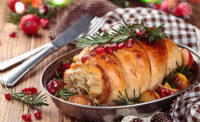Celebratory meals surrounding the fall and winter holidays are gradually becoming less traditional.
While turkey remains the dominant center of the plate protein for Thanksgiving, consumption of such alternatives as pork, lamb, beef and chicken are on the upswing as more consumers seek variety, novelty and affordability when preparing for seasonal gatherings.
Turkey dollar and volume sales were down 3 percent and 4 percent, respectively, during the fourth quarter of 2015 versus the year-earlier period, reports Sarah Schmansky, director of business operations for the Nielsen Perishables Group, a Chicago-based fresh foods consulting and research firm.
Ham sales, meanwhile, are brisk during the fourth quarter, with about half of total yearly activity occurring during the period, she says.
“Ham is seen by consumers as a less expensive solution for holiday parties,” Schmansky says. “Half and quarter hams are functioning as supplemental proteins and are often in the shopping cart along with whole turkeys.”
In addition to more consumers looking to add pizzazz to holiday meals, the strong interest in ham also is being driven by convenience with many shoppers, and particularly younger people who lack the cooking skills of their parents, seeking fully cooked and value-added varieties, including selections that are pre-brined and seasoned, she says.
A changing shopper base
Evolving demographics also contribute to the drop in turkey pound sales, Schmansky says, noting declining birth rates and more empty-nester households are slicing demand for large birds of 15 or more pounds and generating more interest in smaller turkeys of 10 to 12 pounds.
Helping to spur pork activity, meanwhile, is a growing Hispanic population who often prepares pork tamales for holiday meals, and Asian and African-American shoppers who also frequently use pork in recipes, says Patrick Fleming, director of market intelligence and innovation for the Des Moines, Iowa-based National Pork Board.
“Those ethnic groups are over indexing in their consumption of pork during holidays,” he says.
Ease of preparation also is a key pork sales driver. Most consumers typically can cook a roast or boneless loin in 90 minutes, while fully cooked spiral sliced hams just require heating and are simple to serve, Fleming says.
Perhaps the biggest obstacle to maximizing sales of pork and other meat and poultry during the holidays is the reluctance by many retailers to move the spotlight away from turkey in their Thanksgiving advertising or to provide adequate merchandising space for the different proteins in the meat department, he says.
“There is more strain on the meat case during the holidays with additional beef, pork and turkey varieties available,” Fleming says. “We just can’t drop a pallet on the floor of a supermarket for a secondary display because all the pork items must be refrigerated.”
Add life to lamb
A dearth of retail merchandising also has an impact on seasonal lamb sales, says Megan Wortman, executive director of the Denver-based American Lamb Board.
“It is difficult to get shoppers thinking about lamb when it is not on their radar and occupies less than 1 percent of the meat case,” she says. “But many consumers want variety. Once we educate them about lamb being lean and out of the ordinary, it is not a hard sell.”
Lamb is a potentially strong holiday dinner option as many consumers tend to associate the protein with special occasions, Wortman says.
Shoppers in their 20s and 30s are strong candidates for lamb as they tend to not have the negative bias of other consumer segments toward the protein and are looking for new eating experiences, she says.
“Many people in the World War II generation were fed mutton and so were turned off by lamb and that attitude was passed down to the Baby Boomers who also rejected it,” Wortman says. “Today there are many consumers who have never eaten lamb or who love it but only consume lamb at restaurants because they are intimidated to cook meals at home. The goal is to make lamb more approachable.”
While the greatest holiday sales of lamb still occur during Easter and Passover, more activity is happening during Christmas and New Year’s and the American Lamb Board is developing a fall marketing campaign to boost the use of lamb during Friendsgiving, she says. Friendsgiving is a celebratory dinner people have with their friends, usually on the Wednesday before or Friday after Thanksgiving.
The campaign will include a contest with a lamb giveaway and donations to charity when people download menu concepts. The American Lamb Board will support the initiative with a public relations program and advertising on such social media sites as Facebook, YouTube and Instagram.
Other marketing techniques that can generate further lamb activity include the use of on-pack recipes, in-store store signage and cross-promotions, Wortman notes.
Keep talking turkey
Despite the growing consumer interest in having different proteins for their holiday dinners, turkey remains an eminent meal with households typically consuming about 46 million birds during Thanksgiving and approximately 25 million at Christmas, says Joel Brandenberger, president of the Washington, D.C.-based National Turkey Federation.
However, he stresses it remains crucial for processors and retailers to heavily merchandise the poultry if they are to sustain or grow activity.
“No industry is safe if it rests on its laurels,” Brandenberger says. “It is important to keep building on the strength of turkey being a holiday tradition while also being attuned to changing trends.”
Such trends include greater shopper focus on convenience and variety, which is resulting in growing demand for value-added selections, including turkeys that are brined or seasoned and come in self-roasting bags, he says.
“It is important to connect to tradition while also recognizing that consumers’ lifestyles are changing and there always is a desire to jazz the meal up,” Brandenberger says. “Consumers won’t get less busy so they will keep looking for meals that are easy to prepare,”
Merchandisers, meanwhile, can help bolster turkey activity by spotlighting the poultry’s role as an attractive ingredient in post-holiday leftover meals, he says, suggesting casseroles, gumbo and enchiladas.
A change of seasons
Among the holiday dinner protein alternatives growing in stature are meat and poultry cuts that are more commonly associated with spring and summer grilling.
Weekly sales of beef ribeye roast in the 2015 Thanksgiving-to-New Year’s period, for instance, were two times greater than an average week, and five times greater during the week before Christmas, says John Lundeen, senior executive director of market research for the Centennial, Colo.-based National Cattlemen’s Beef Association (NCBA), a contractor to the Beef Checkoff.
Consumers, however, more frequently list beef ribeye roast as an attractive meal for seasonal dinner parties and entertainment rather than a Thanksgiving Day or Christmas Day center of the plate option, he says.
To make such newer alternatives more appealing, however, it is important that merchandisers distribute cooking instructions with cuts as many shoppers often lack experience in preparing the selections, he states.
“There is a sizeable minority of folks that need some handholding,” Lundeen says. “That especially includes younger shoppers who are open to receiving information through different sources, including social media and such traditional methods as on-pack labels. It is important to show that preparation does not have to be intimidating.”Chicken, meanwhile, is a grilling favorite that, because of its versatility and affordability, also is in position to become more prominent during fourth quarter gatherings, says Tom Super, vice president of the Washington, D.C.-based National Chicken Council.
Selections that are increasingly prevalent at holiday dinners include prepared options, such as nuggets, strips and meatballs, as well as smaller sandwiches that contain breast or thigh meat and ground chicken, as well as chicken tenders.
Because there will likely be a surplus of boneless/skinless breast meat during the fourth quarter, chicken prices will remain attractive and there will likely be an increase in the assortments and quantity of chicken rollups during the holiday season, Super notes. Selections will feature traditional holiday fillings, such as fig-based mixtures, as well as ancient grains and lesser known fruits and vegetables, he says.
Also becoming more popular, he adds, are larger roaster chickens, which are providing “manageable leftovers,” and smaller Cornish game hens.
“The traditional fall and winter holiday meals include a wider range of eating occasions and larger gatherings that tend to trigger a different approach to the menu and foods served,” Super says.
With more shoppers also relying on home delivery of holiday meals in lieu of preparing elaborate recipes, there will be greater interest in exotic and ethnic-oriented selections, he says.
“Look for stores to ramp up their imagination while not turning off too many of the more traditional holiday food shoppers,” Super says. “The low cost of boneless/skinless breast meat will ease the risk of this experimentation.” NP
Promotions are paramount
With more shoppers considering a wider range of protein options for their holiday dinners, it is crucial that merchandisers enhance product marketing if the alternatives are to be seen as vibrant and viable.
Because of tradition and demand, many retailers still primarily promote turkey for the holidays, making it more difficult to lure shoppers to the alternative proteins, says Sarah Schmansky, director of business operations for the Nielsen Perishables Group, a Chicago-based fresh foods consulting and research firm.
Nevertheless, some relatively simple marketing activities can result in potentially large paybacks. They include promotions that make trying new options particularly attractive, such as offering a free turkey with a ham purchase or co-merchandising items in advertisements, she says.
Educating shoppers on how to best prepare the proteins and offering in-store samples of value-added options a few weeks before the holidays also will make selections more appealing, Schmansky says. Such recipes as spiced lamb chops or kabobs, for instance, will demonstrate how shoppers can “spice up” holiday meals, she adds.
Retailers that post videos with cooking instructions and meal ideas on their websites also will help ease shopper anxiety over preparing novel dishes, says Patrick Fleming, director of market intelligence and innovation for the Des Moines, Iowa-based National Pork Board.
“It is important to communicate, for instance, that most hams are fully cooked and users just have to warm up the meat and glaze, while also showing that the products are flexible enough for use during holiday meals and then for sandwiches later on,” he says.
— Rich Mitchell






Report Abusive Comment